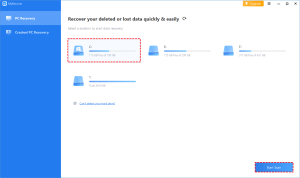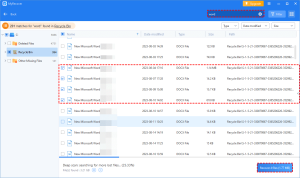Have you ever experienced that heartbreaking moment when you realize an important file is missing? Whether due to accidental deletion, malware attack, or system failure, losing important data can be a major setback. Data file recovery tools are invaluable in these situations, offering the chance to retrieve crucial files that would otherwise be lost forever due to accidental deletions or unexpected system failures.
But the good news is: the files are not lost! In this guide, we’ll explore data recovery to ensure you’re able to recover lost or deleted files.
Can I Recover Deleted Files in Windows 10/11?
Is it possible to recover permanently deleted files? The answer is YES! Before we delve into recovery methods, let us clear up a common misconception: Once a file is deleted, it is not immediately erased from the storage device. Instead, the space it occupies is simply marked as available for new data.
This means that with the right tools and a little luck, you can recover lost or deleted files before they are overwritten. The key to successful file recovery is to act quickly to increase your success rate.
How to Recover Deleted Files in Windows 10/11 Easily
When the Recycle Bin is empty or you have no backup, we recommend you use this professional Windows recovery software such as MyRecover. It stands out in the crowded field of data recovery software, thanks to its user-friendly interface and powerful recovery capabilities.
Whether you’re dealing with lost photos, documents, or videos, MyRecover offers a simple recovery process. Let us explore the key features of MyRecover.
- Support 200+ file formats, so you can recover Word, Excel, PPT, JPG, PNG, MP3, MP4, WMV and more.
- Support filter, preview, and recover deleted or lost files during the scanning process. And retain their original file name, format, path and quality.
- Recover deleted or lost files from HDDs, SSDs, SD cards, USB flash drives and more.
- Support almost all Windows systems including Windows 7, 8, 10, 11, and Windows Server.
Now, please follow the simple steps below to recover deleted files in Windows 10/11.
Step 1. Download and run MyRecover on your computer; select the partition or drive where your files are deleted, and click Start Scan.

Step 2. The combined scanning methods – Quick Scan & Deep Scan will automatically scan all the deleted or lost files on your selected drive.

Step 3. Select the files you want to recover and click Recover x files. It will display the number of files and their entire size.

Step 4. You will be asked to choose a new location instead of the original location to avoid data overwriting. Then, click Select Folder to confirm.
How to Prevent Data Loss in the Future?
Preventing data loss in the future is critical. Here are 5 tips you can take to minimize the risk of future data loss.
- Back up your data regularly: The most reliable way to prevent data loss is to back up important files regularly. Try using this free Windows backup tool – AOMEI Backupper for automated file backups.
- Use antivirus and anti-malware software: Protect your computer with reliable antivirus software can prevent malware from damaging your files.
- Practice safe browsing habits: Please be careful about the websites you visit and the links you click. Avoid opening and downloading files or attachments from untrusted sources.
- Monitor the health of your hardware: Keep an eye on the health of your hard drives and other storage devices.
- Avoid physical damage: Avoid exposing your storage device to extreme temperatures, moisture, physical shock or drops.
Summary
Losing important files can be a painful experience. But as we’ve seen, with the right knowledge and tools like MyRecover, file recovery is often possible, even simple. It helps you perform lost or deleted file recovery with a high success rate and fast speed.
Furthermore, it can recover data easily and quickly whether you have lost data due to accidental deletion, disk formatting, virus infection, system crash etc. Remember, the key to successful file recovery is to act quickly and choose the method that best suits your situation.



